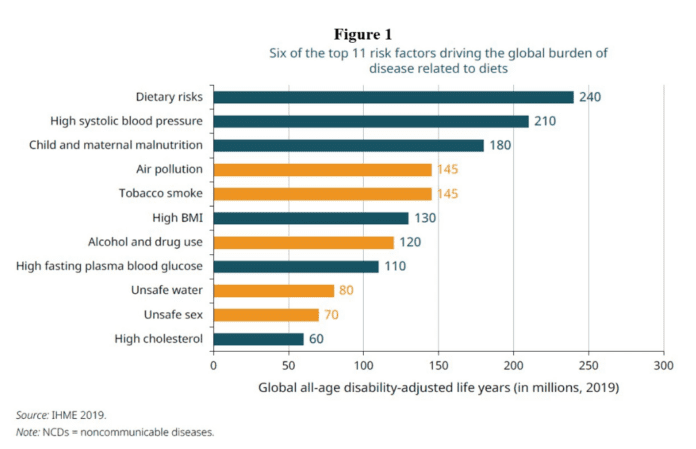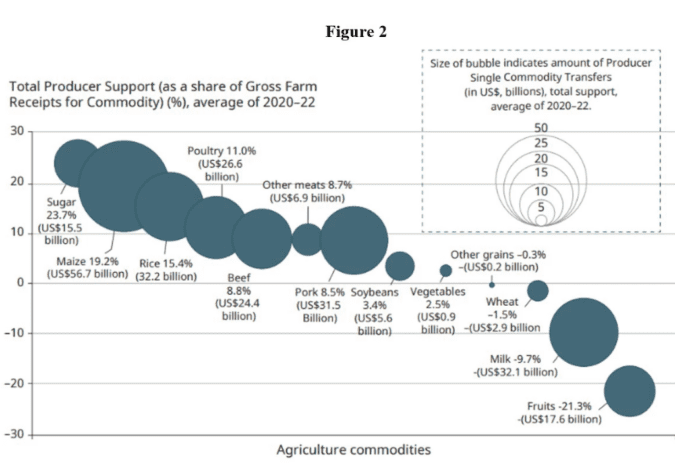By Natasha Hayward, Felipe F. Dizon, Elizabeth Ludwig-Borycz, and Dwi Sari Puspaningtyas
We are off track in addressing malnutrition
While hunger is making headlines, malnutrition continues to silently affect millions worldwide, undermining their physical and mental capacities and constraining their productivity. Women and children are most at risk. In 2022, over 20 percent of children under five were stunted, increasing mortality and lowering future earnings, while 16 percent of adults were obese, driving up noncommunicable diseases, a growing cause of global deaths.

These forms of malnutrition also translate into huge costs to society. The food system’s hidden health costs amount to $6.6 trillion, equaling two-thirds of its market value. Malnutrition—including undernutrition, overweight, and obesity— represents significant costs, driving up healthcare expenditure and reducing incomes. In 2020 alone, overweight and obesity cost close to $2 trillion, with projections reaching $4.3 trillion within a decade and considerable consequences for individuals and societies.
Unhealthy diets and high food prices are among the core drivers of malnutrition. In addition to continued challenges in availability and access to healthier foods among lower income households and in disadvantaged areas, increasingly, people eat too much sugar, red meat, and processed meat, while not eating enough whole grains, fruits, and vegetables.
The shift away from more traditional diets and towards ultra-processed foods is a big part of the problem. Owing to the consensus on the increasing burden of diet-related diseases, the World Health Organization (WHO) and the Food and Agriculture Organization (FAO) have created dietary guidelines on which foods to limit and which to consume in greater quantities.
Rethinking public support to promote healthier diets
Clearly, public finance and policies in the agrifood sector – estimated at over $800 billion gross per year – have an important share of responsibility. That support comes largely in the form of trade and market policies that distort prices, rather than supporting public goods such as infrastructure and research and development. Further, most of this support focuses on wealthier farmers instead of consumers or farmers most in need.
In addition, public support to the agrifood sector tends to favor commodities already high in demand, such as grains, meats, and sugar, and much less on under-consumed, healthier food commodities such as fruits, vegetables, and dairy (See Figure 2).
This imbalance can create a disconnect between agrifood policies and health objectives. For example, several countries tax the consumption of sugar-sweetened beverages while subsidizing production of sugar which is an ingredient into these beverages. In these countries with seemingly inconsistent policies around sugar consumption and production, levels of sugar consumption exceed the WHO recommendations.

Given the significant costs of malnutrition, agrifood support must be restructured to promote healthy diets. While repurposing agrifood support involves trade-offs, it also presents opportunities for synergies that deliver benefits across multiple outcomes.
One simulation scenario shows that repurposing agrifood subsidies from producers to consumers —targeting priority foods that support healthy diets— can lead to reductions in extreme poverty, particularly in lower income countries, as well as lower greenhouse gas emissions and increased affordability of nutritious foods.
Translating global advocay into country-led action for healthier diets
Our new report “Reshaping the Agrifood Sector for Healthier Diets: Exploring the Links between Agrifood Public Support and Diet Quality” shows that solutions to promote healthier diets must be tailored to each country’s specific context.
There is no one-size-fits all formula to determine the right composition and amount of public support in any given country. For example, our report shows that investing in infrastructure and research can boost food availability and consumption, including for less healthy options. Likewise, easing trade and market restrictions tends to improve market efficiency and reduce prices but can also increase consumption of unhealthy foods.
Pairing agrifood reforms with health and social protection measures can yield benefits and avoid harm, especially for the most vulnerable, but they should also consider local circumstances.
In Bangladesh, for instance, rural roads are correlated with healthier diets, while input subsidies are not. In Malawi, input subsidies have improved food security but failed to enhance diet diversity, whereas cash transfers have improved the latter.
Building on our clear vision for healthier diets
Improving the efficiency of current programs holds promise, and has created momentum to rethink the effectiveness of input subsidies in countries such as Bangladesh and Malawi, including through the introduction of e-voucher system pilots paving the way for improved input subsidy programs.
Building nutrition more explicitly in agrifood projects will also play a key role. In the West Africa Food Systems Resilience Program, Senegal will increase national capacity to fill information gaps on vulnerability, nutrition, and food security to inform tailored actions to address food insecurity risks. The Program in Senegal also supports nutrition-sensitive value chains, such as horticulture, dairy, and meat, with a focus on supporting women and youth.
In Brazil, the Bahia Sustainable Rural Development Project is bridging the gap between organization of family farmers and institutional markets, in particular the National School Feeding Program. The project not only addresses productive inclusion of family farmers but also ensures that children access healthy and nutritious food in schools. It reinforces complementary public policies that link agriculture, food and nutrition security, and social protection.
In 2021, the World Bank made an important commitment at the Nutrition for Growth Summit in Tokyo to mainstream nutrition in its agrifood projects. Today, as the Nutrition for Growth Summit in Paris begins, we are more convinced than ever that nutrition-sensitive agriculture and healthy and sustainable diets hold the key to getting us back on track when it comes to tackling malnutrition.
-This is the first in a series of blogs about the role of the agriculture and food sector in promoting healthy diets and better nutrition.
![]()
The post Reshaping the agriculture and food sector for healthier diets appeared first on Caribbean News Global.
